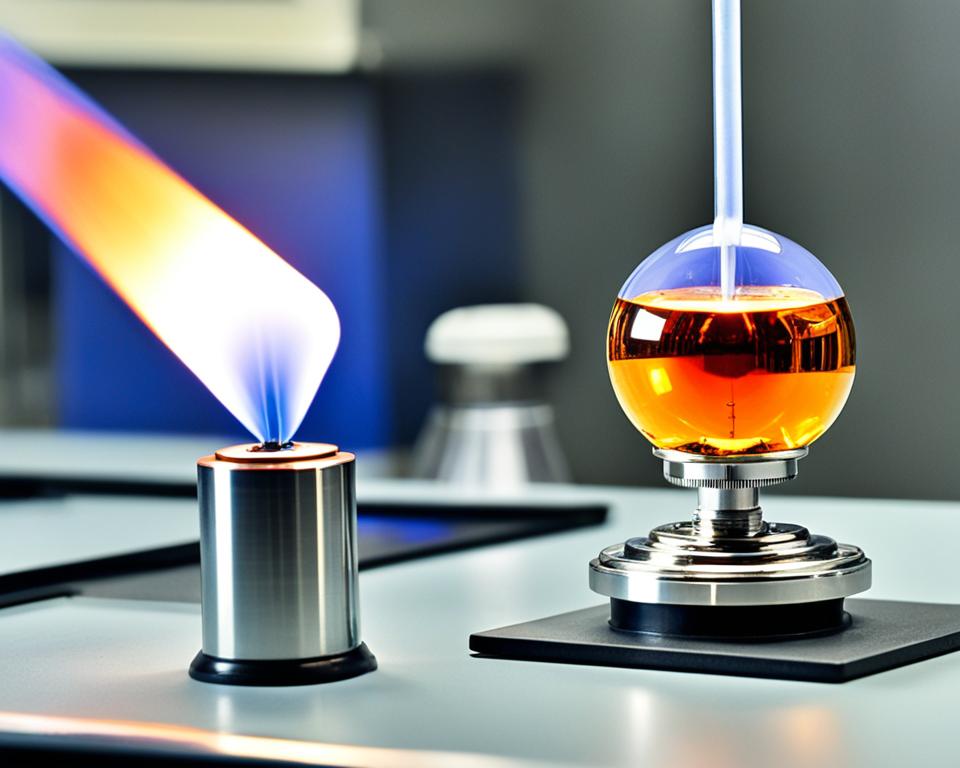Welcome to our article on the uses of thallium! Thallium, a chemical element with symbol Tl, has found widespread applications in a variety of industries and fields. From medical imaging to glass manufacturing, thallium’s unique properties have made it a valuable resource for scientific and technological advancements.
In this section, we will explore the various uses and applications of thallium in different industries and fields. Let’s dive in and discover the versatility of this fascinating element!
Key Takeaways:
- Thallium has diverse applications in medical imaging, electronics, glass manufacturing, catalysis, radiation detection, photography, and more.
- Thallium plays a crucial role in nuclear medicine, enabling accurate diagnostic procedures and the detection of certain medical conditions.
- In the field of electronics, thallium is used in semiconductors, photodetectors, and optical fibers, contributing to the development of electronic devices.
- Thallium-based compounds are utilized as antidotes and therapies in the treatment of thallium poisoning cases.
- In glass manufacturing, thallium additives enhance properties such as color, refractivity, and electrical conductivity.
Medical Imaging

Thallium, a highly versatile element, has proven to be an invaluable tool in the field of medical imaging, particularly in nuclear medicine. Its unique properties and applications have revolutionized diagnostic procedures, enabling healthcare professionals to detect and diagnose certain medical conditions with greater precision and accuracy.
One of the key applications of thallium in medical imaging is its use in the development of thallium-based radiopharmaceuticals. These radiopharmaceuticals consist of thallium-201, a radioactive isotope of thallium, that emit gamma rays which can be detected by specialized imaging equipment.
This image showcases an example of thallium-based radiopharmaceuticals in action:
Thallium-based radiopharmaceuticals are commonly used in procedures such as thallium myocardial perfusion scans, also known as thallium stress tests, which evaluate blood flow to the heart muscle. These scans help diagnose coronary artery disease and identify areas of reduced blood flow to the heart. Thallium imaging has also shown promise in detecting and localizing tumors, particularly in the brain and thyroid.
The benefits of using thallium in medical imaging are multifaceted. Its high affinity for certain tissues allows for targeted imaging, improving the detection of abnormalities. Thallium imaging techniques also offer superior spatial resolution, enabling healthcare professionals to visualize subtle changes in organ structures or identify early-stage tumors that may be missed by other imaging modalities.
Thallium in Medical Imaging: Key Benefits
- Enhanced detection and localization of tumors
- Improved visualization of blood flow to the heart muscle
- Superior spatial resolution for precise imaging
- Targeted imaging of specific tissues or organs
The use of thallium in medical imaging continues to evolve, with ongoing research and advancements in radiopharmaceutical development. Its unique properties and applications make it an indispensable tool in the diagnosis and management of various medical conditions.
Electronics
![]()
Thallium has proven to be an essential element in the advancement of electronic devices and components. Its unique properties have enabled its application in various areas of electronics, including semiconductors, photodetectors, and optical fibers.
Semiconductors
Thallium-based semiconductors have revolutionized the field of electronics. These compounds offer remarkable electrical conductivity and impressive photoresponse, making them ideal for semiconductor devices.
Thallium arsenide (TlAs) and thallium antimonide (TlSb) are two examples of thallium-based semiconductors that have gained significant attention in the industry. These materials exhibit impressive carrier mobility, enabling faster electronic device operation.
Furthermore, thallium-based semiconductors have shown promise for applications in high-frequency electronic devices, such as transistors and integrated circuits. Their excellent thermal stability and low noise characteristics make them suitable for use in communication systems.
Photodetectors
Thallium compounds are widely used in photodetectors due to their excellent sensitivity to light. Thallium-based photodetectors can convert light signals into electrical signals, allowing for precise detection and measurement in various applications.
Thallium-based photodetectors find extensive use in fields such as telecommunications, scientific research, and aerospace. Their high-speed response and sensitivity to a wide range of wavelengths make them well-suited for optical communication systems and imaging devices.
Optical Fibers
Thallium has also made significant contributions to the development of optical fibers. Thallium-based glasses have been used as additives in fiber optics to enhance their transmission properties and efficiency.
Thallium-doped glasses can improve the refractive index of the optical fibers, allowing for better signal transmission over long distances without significant loss. This is crucial for high-speed data communication and telecommunications networks.
In addition, thallium-doped fibers have been utilized in special applications such as fiber lasers and amplifiers, where their unique properties enable efficient light generation and amplification.
Thallium’s presence in electronics continues to drive innovation and drive the development of cutting-edge technologies. Its versatility and remarkable properties make it an indispensable element in the world of electronics.
Poisoning Treatment

Thallium poisoning can have serious consequences for the human body, but interestingly, thallium also plays a role in its own treatment process. Thallium-based compounds have been developed as effective antidotes and therapies for thallium poisoning cases.
When administered as a treatment, these compounds work by promoting the elimination of thallium from the body and mitigating its toxic effects. They facilitate the detoxification process, allowing the body to expel the harmful thallium more efficiently.
Researchers have discovered that specific compounds, such as Prussian blue and potassium ferric ferrocyanide, are effective in binding to thallium ions in the body. These compounds form stable complexes that prevent the absorption and redistribution of thallium, effectively reducing its toxicity.
Additionally, various therapeutic approaches, such as chelation therapy, have been explored for thallium poisoning treatment. Chelating agents, such as dimercaptopropanesulfonic acid (DMPS) and dimercaptosuccinic acid (DMSA), can bind to thallium ions and enhance their excretion through urine, facilitating the detoxification process.
Thallium poisoning treatment involves the use of specific compounds and therapeutic approaches that help eliminate thallium from the body, mitigating its toxic effects.
In severe cases, hemodialysis may be employed to remove thallium from the bloodstream. This technique involves filtering the blood through a machine to remove toxins and waste products. While not specific to thallium, hemodialysis can be used as a complementary treatment method in conjunction with other thallium detoxification methods.
It is important to note that thallium poisoning cases require immediate medical attention and should only be treated under the supervision of healthcare professionals. Early detection, prompt treatment, and appropriate supportive care are critical for a successful recovery.
Thallium poisoning treatment and detoxification methods are constantly evolving as researchers continue to explore new ways to combat this serious health issue. Ongoing studies aim to develop more targeted and efficient treatments to counteract the harmful effects of thallium poisoning.
Thallium Poisoning Treatment Methods
Below is a table summarizing the different thallium poisoning treatment methods and their specific mechanisms:
| Treatment Method | Mechanism |
|---|---|
| Administration of thallium-binding compounds (e.g., Prussian blue) | Forms stable complexes with thallium ions, reducing absorption and toxicity |
| Chelation therapy with chelating agents (e.g., DMPS, DMSA) | Binds to thallium ions, facilitating their excretion through urine |
| Hemodialysis | Filters the blood to remove thallium and other toxins |
Glass Manufacturing

Thallium compounds play a crucial role in the glass manufacturing industry, where they are used as additives to enhance various properties of glass products. These thallium-based glass additives have a significant impact on the color, refractivity, and electrical conductivity of the glass.
By incorporating thallium into glass production, manufacturers can create glass with unique characteristics that meet specific requirements for different applications. Thallium is known for its ability to produce vibrant colors, making it ideal for producing stained glass and decorative glassware.
In addition to color enhancement, thallium-based additives also improve the refractivity of glass, making it suitable for optical applications such as lenses and prisms. The controlled addition of thallium can alter the refractive index, allowing for the production of lenses with specific optical properties.
Thallium’s electrical conductivity properties make it valuable for manufacturing glass with specific electrical properties. By adding thallium, manufacturers can produce glass with enhanced electrical conductivity, which is used in applications such as cathode ray tubes.
Thallium-based glass additives are carefully measured and added during the glass production process to achieve the desired properties. The precise composition and amount of thallium added determine the final characteristics of the glass.
Benefits of Thallium in Glass Manufacturing:
- Enhanced color options for stained glass and decorative glassware.
- Improved refractivity for lenses and prisms in optical applications.
- Customized electrical conductivity properties for specialized glass products.
Thallium compounds have revolutionized the glass manufacturing industry by providing a wide range of possibilities for glass product development. From stunning colors to advanced optical properties, thallium-based glass additives offer immense versatility for designers and manufacturers alike.
| Glass Property | Thallium’s Impact |
|---|---|
| Color | Thallium-based additives create vibrant and diverse color options for stained glass and decorative glassware. |
| Refractivity | Thallium enhances the refractive index of glass, making it suitable for lenses and prisms in optical applications. |
| Electrical Conductivity | Thallium improves the electrical conductivity of glass, enabling its use in specialized applications like cathode ray tubes. |
Chemical Catalysts

Thallium compounds have proven to be effective catalysts in various chemical reactions, making them highly valuable in organic synthesis and industrial processes. These thallium catalysts exhibit unique properties that enable them to enhance reaction rates, selectivity, and efficiency.
Thallium-based catalytic reactions are widely employed in the production of pharmaceuticals, fine chemicals, and organic compounds. They play a vital role in accelerating chemical transformations and facilitating the synthesis of complex molecules.
One notable application of thallium catalysts is in the synthesis of heterocyclic compounds, which are essential building blocks in drug discovery and development. Thallium-based catalytic reactions have shown remarkable efficiency in constructing diverse heterocyclic frameworks, enabling the production of novel pharmaceutical candidates.
Another significant area where thallium catalysts excel is in the oxidation of organic compounds. Thallium-based catalysts have been found to effectively promote selective oxidation reactions, leading to the synthesis of valuable intermediates and oxidation products.
Thallium catalysts offer immense potential for the development of sustainable and efficient chemical processes. Their unique catalytic properties, coupled with their relatively low cost and availability, make them attractive options for industrial applications.
Furthermore, thallium catalysts have demonstrated excellent performance in various transformations, including carbon-carbon bond formation, carbon-heteroatom bond formation, and asymmetric synthesis.
Overall, the use of thallium catalysts in chemical reactions showcases their versatility and effectiveness in promoting a wide range of transformations. Their contributions to organic synthesis and industrial processes are significant and continue to drive advancements in various fields.
Inorganic Reactions
In addition to organic synthesis, thallium catalysts also find application in inorganic reactions. They have been employed in the synthesis of inorganic materials, such as nanoparticles and thin films, with unique structures and properties.
The catalytic activity of thallium compounds in inorganic reactions offers opportunities for the development of advanced materials with tailored characteristics, including enhanced conductivity, optical properties, and catalytic performance.
| Applications of Thallium Catalysts | Benefits |
|---|---|
| Heterocyclic compound synthesis | Efficient construction of diverse heterocyclic frameworks |
| Selective oxidation reactions | Synthesis of valuable intermediates and oxidation products |
| Organic transformations | Promotion of carbon-carbon and carbon-heteroatom bond formation, asymmetric synthesis |
| Inorganic materials synthesis | Creation of advanced materials with tailored properties |
Scintillation Counters

Thallium-activated sodium iodide detectors, also known as thallium scintillation counters, are widely used in radiation detection and measurement. These sophisticated devices play a critical role in various fields, such as environmental monitoring and nuclear physics research.
Thallium scintillation counters offer a high level of sensitivity and accuracy, making them indispensable tools for detecting and quantifying radiation. The process involves the interaction of incoming radiation with the thallium-activated sodium iodide crystal, causing the emission of light photons. These photons are then captured and converted into electrical signals, which can be analyzed and interpreted to determine the type and intensity of the radiation.
One of the key advantages of thallium scintillation counters is their ability to efficiently detect a wide range of radiation, including gamma rays and X-rays. These detectors are highly responsive and can accurately measure low levels of radiation, making them invaluable for environmental radiation monitoring, medical imaging, and other applications that require precise measurements.
Thallium scintillation counters have revolutionized the field of nuclear physics research, enabling scientists to explore the properties and behavior of subatomic particles with unprecedented detail and accuracy.
The versatility of thallium scintillation counters extends beyond scientific research. They are also used in various industries that require radiation detection and safety protocols. For example, in the nuclear power industry, these detectors play a crucial role in monitoring radiation levels to safeguard the health and safety of workers and the surrounding environment.
Advantages of Thallium Scintillation Counters:
- High sensitivity and accuracy in detecting radiation
- Efficient measurement of low levels of radiation
- Wide detection range, including gamma rays and X-rays
- Indispensable tool for environmental monitoring and nuclear physics research
- Essential for ensuring radiation safety in industries like nuclear power
Thallium scintillation counters have revolutionized radiation detection and measurement, providing invaluable insights and data across a range of scientific, industrial, and medical fields. The combination of thallium’s unique properties and the advanced technology of these devices has paved the way for groundbreaking discoveries and enhanced safety practices.
Photography

Thallium-based compounds have revolutionized the world of photography, offering photographers a range of creative possibilities and unique visual effects. These compounds are prized for their exceptional light sensitivity and their ability to react with light to produce stunning images that captivate viewers.
Thallium’s role in photography can be attributed to its use in photochemical processes, where it interacts with light to create chemical changes in the film or sensor. This results in the formation of latent images that can be developed into full-fledged photographs.
Thallium’s light-sensitive properties make it ideal for photography. Its ability to capture subtle nuances of light and shadow brings a depth and richness to images that is difficult to achieve with other materials.
By incorporating thallium-based compounds into their photographic workflow, photographers can explore a whole new realm of artistic expression. The unique properties of thallium allow photographers to experiment with long exposures, double exposures, and other creative techniques that produce striking and ethereal images.
Moreover, thallium-based compounds enable photographers to achieve remarkable tonal range and contrast, enhancing the overall visual impact of their photographs. The delicate balance of light and shadow, coupled with the intricate details captured by thallium, creates images that truly come alive.
The use of thallium in photography elevates the art form to new heights. It empowers photographers to push the boundaries of their creativity and deliver images that evoke emotions and tell compelling stories.
Whether it’s capturing the beauty of nature, immortalizing a candid moment, or experimenting with abstract compositions, thallium-based compounds have become an indispensable tool for photographers seeking to create impactful visual narratives.
The integration of thallium in photochemical processes has undoubtedly contributed to the advancement of photography as an art form. Its ability to transform light into tangible memories has forever changed how we perceive and appreciate the world through the lens.
| Advantages of Thallium in Photography | Examples |
|---|---|
| Enhanced light sensitivity | Stunning low-light and night photography |
| Unique visual effects | Dreamy, ethereal landscapes |
| Expanded tonal range | High-contrast black and white photography |
| Creative flexibility | Experimental techniques like double exposures |
Conclusion
In conclusion, thallium is a versatile element that finds numerous applications in various industries. Its unique properties have made it an invaluable resource in fields such as medical imaging, electronics, glass manufacturing, catalysis, radiation detection, and photography.
In the medical field, thallium is used in imaging techniques like nuclear medicine, aiding in the diagnosis of certain medical conditions. In electronics, thallium plays a crucial role in the development of semiconductors, photodetectors, and optical fibers, contributing to the advancement of electronic devices.
Thallium also has applications in glass manufacturing, enhancing the properties of glass products such as color, refractivity, and electrical conductivity. As a catalyst, thallium compounds have shown their effectiveness in organic synthesis and various industrial processes.
Moreover, thallium-activated sodium iodide detectors, known as scintillation counters, are widely used in radiation detection and measurement, playing a vital role in fields like environmental monitoring and nuclear physics research. Additionally, thallium-based compounds have been utilized in photography for their light sensitivity and their ability to create unique effects.
With its diverse range of applications, thallium continues to drive scientific and technological advancements, pushing the boundaries of what is possible in various industries and fields.
FAQ
What are the uses of thallium?
Thallium has various applications in different industries and fields. It is used in medical imaging, electronics, glass manufacturing, chemical catalysts, radiation detection, and photography, among others.
How is thallium used in medical imaging?
Thallium is used in medical imaging techniques, specifically in nuclear medicine. It is employed as a radiopharmaceutical in diagnostic procedures to detect certain medical conditions.
What is thallium’s role in the electronics industry?
Thallium plays a vital role in electronics. It is used in the production of semiconductors, photodetectors, and optical fibers, contributing to the development of electronic devices and components.
Can thallium be used in the treatment of poisoning?
Yes, thallium-based compounds can be utilized in the treatment of thallium poisoning. They function as antidotes and therapies to counteract the effects of thallium toxicity.
How is thallium utilized in glass manufacturing?
Thallium compounds are used as additives in glass production to enhance properties such as color, refractivity, and electrical conductivity of glass products.
What is the significance of thallium as a chemical catalyst?
Thallium compounds exhibit catalytic properties, which make them valuable in organic synthesis and industrial processes involving various chemical reactions.
What is the role of thallium in scintillation counters?
Thallium-activated sodium iodide detectors, known as thallium scintillation counters, are commonly used in radiation detection and measurement for applications like environmental monitoring and nuclear physics research.
How is thallium utilized in photography?
Thallium-based compounds are used in photography due to their light sensitivity and ability to create unique photographic effects through photochemical processes.
What are the practical applications of thallium?
Thallium has practical applications in various industries such as healthcare, electronics, manufacturing, research, and art. Its unique properties make it valuable in diverse fields.




